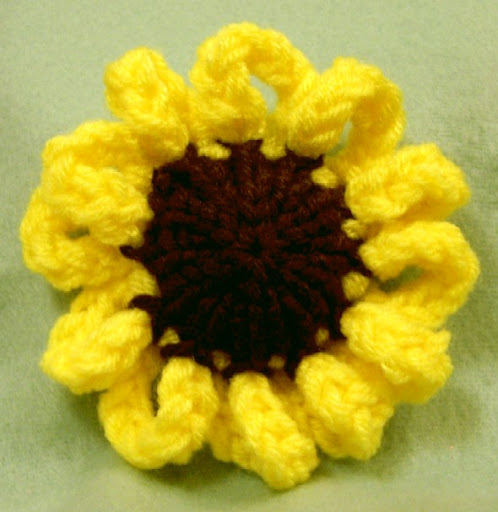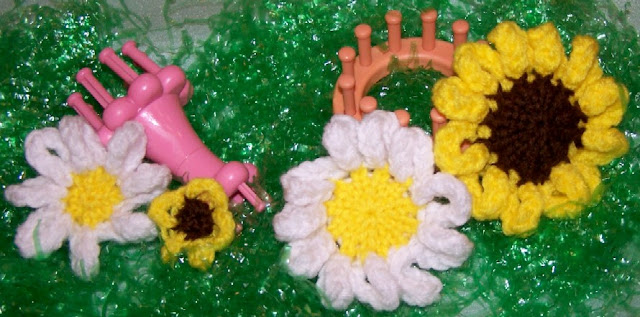 My desire to knit a flower has been germinating every since I first picked up the Knifty Knitter flower loom and last night the idea came into full bloom. When I went to bed and couldn't sleep, I tried counting sheep, but it only made me think of yarn. The next thing I knew I was playing with my flower loom. I had been toying with the idea of using the drawstring cast on to create the center of a flower after using it with the Easter egg pattern. Then when I used the I-cord stitch for the scalloped rim on the jellybean basket, I decided it looked a lot like flower petals, so I set to work to test my theory. The large sunflower above was the results of my runaway imagination. After completing the sunflower, I went to sleep dreaming of other possibilities and more flowers.
My desire to knit a flower has been germinating every since I first picked up the Knifty Knitter flower loom and last night the idea came into full bloom. When I went to bed and couldn't sleep, I tried counting sheep, but it only made me think of yarn. The next thing I knew I was playing with my flower loom. I had been toying with the idea of using the drawstring cast on to create the center of a flower after using it with the Easter egg pattern. Then when I used the I-cord stitch for the scalloped rim on the jellybean basket, I decided it looked a lot like flower petals, so I set to work to test my theory. The large sunflower above was the results of my runaway imagination. After completing the sunflower, I went to sleep dreaming of other possibilities and more flowers.Today ended up being "car trip" day, which means time to loom knit. I tested various looms and changed the number of rows each time. The picture below shows the flowers I made during the car trip pictured with it's corresponding loom, along with the "bedtime" sunflower. The daisy & black-eyed Susan were made with the spool loom: the daisy on the eight peg end and the black-eyed Susan on the five peg end. The large daisy and the sunflower were made on the twelve peg flower loom.
 I do not recommend the spool loom for your first flower. It's very cumbersome to work with, especially on the five peg end where the inside loom opening is very narrow. The twelve peg flower loom produced the best flowers, but they are also quite large having a four & one-half inch diameter.
I do not recommend the spool loom for your first flower. It's very cumbersome to work with, especially on the five peg end where the inside loom opening is very narrow. The twelve peg flower loom produced the best flowers, but they are also quite large having a four & one-half inch diameter.How to grow sunflowers on the flower loom
Unfortunately, I'm pressed for time right now and will not be able to write a detailed pattern until I return from vacation at the end of the month. However, you will find the flowers quite easy to make if you are familiar with my drawstring cast on method (see the Easter egg pattern) and the scalloped I-cord stitch trim I used in the little jellybean basket. Do a drawstring cast on using the twelve peg flower loom and two strands of Red Heart worsted weight yarn in brown or your chosen color. Flat knit Rows 1-4 and on Row 5 do e-wrap knit stitches. Cinch the center opening shut by pulling on the initial yarn tail from the drawstring cast on. Pull the yarn tail to the inside and tie off. Change yarn colors to two strands of bright yellow. Row 6 consists of a nine stitch I-cord pattern. On Row 7, lift the ladders from Row 5 to do a hang-hem, then knit the bottom loops over the hang-hem loops. Row 8 is an e-wrap knit stitch row and Row 9 is the flat panel bind off row. End by tying off, securing and trimming all yarn tails.
Experiment on your own using various yarns and modified stitches. Be sure and share pictures of your accomplishments so we can all learn from them. The possibilities are endless.
